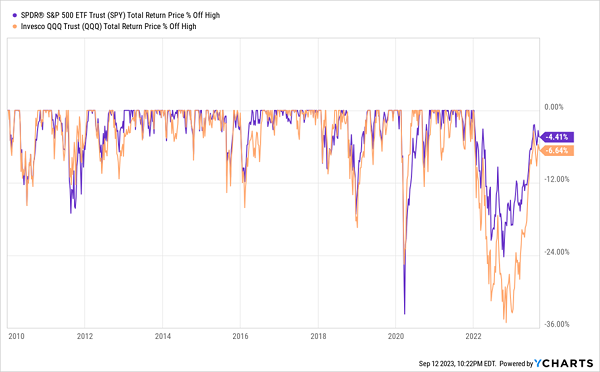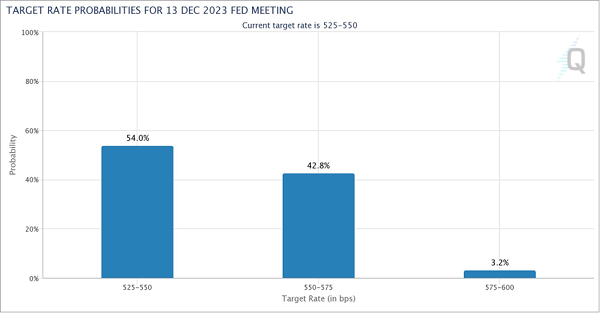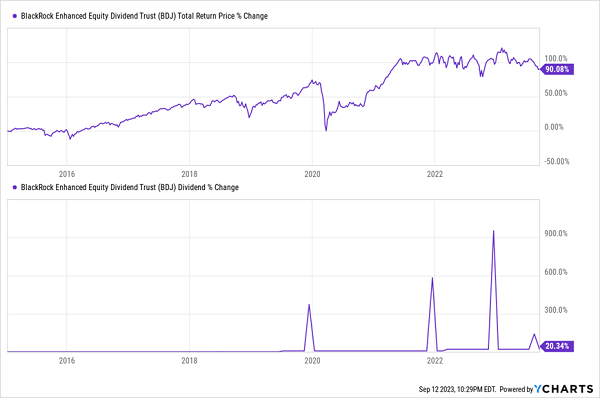This Looming “Fed Shift” Will Ignite These 8%+ Payers
All year long, we’ve been waiting for our favorite high-yield investments, 8%+ yielding closed-end funds (CEFs), to jump, along with the rest of the market.
Now, nearly nine months in, we’re still waiting! It’s not surprising: the income-focused investors who buy these funds are typically a cautious bunch.
Not that we mind at my CEF Insider service. We’ve been taking advantage of the extra time to pick up bargain funds and build our income streams. As I write this, our CEF Insider portfolio yields around 9%, with many of our picks paying dividends monthly.
But a fresh report from the Federal Reserve Bank of Chicago is a sign the CEF train could be about to leave the station. The report in question is the September Chicago Fed Letter. Here are the three key forecasts it makes:
- Inflation will fall to 2% by the middle of 2024.
- GDP will keep growing, but at a decelerating pace.
- Both of the above can be accomplished without further interest-rate increases.
In other words, our economic data is on a path to a soft landing. And that means stocks, which remain a good distance off the all-time highs they hit in 2021, are doubly undervalued.
Stocks—and by Extension CEFs—Fail to Price in Improving Outlook
What’s more, we can grab an even better deal on blue chip stocks when we buy them through CEFs like the 8.9%-paying BlackRock Enhanced Equity Dividend Trust (BDJ), thanks to its 11% discount to net asset value (NAV, or the value of the holdings in their underlying portfolios).
That markdown essentially means we can access BDJ’s portfolio of blue chips, like American International Group (AIG), Kraft-Heinz Co. (KHC) and medical-equipment suppliers Baxter International (BAX) and Medtronic plc (MDT), for 11% less than we’d pay if we bought them ourselves on the public market.
Now there is a potential fly in the ointment here: sure, what the Chicago Fed had to say is encouraging (so much so that I’ve seen some cynical takes on the internet saying this is just the Fed patting itself on the back—it isn’t).
But will Powell take it to heart? After all, he’s contradicted all three of these statements within the last couple of months, and he has insisted that the Fed will keep raising interest rates despite market belief it will stop.
That’s why market expectations for interest rates kept going up throughout 2023, and it’s also why the market is almost evenly split on whether the Fed will raise rates again or keep them stable before the end of this year.
Whether or not this indicates a schism in the Fed or the Fed slowly changing its mind, it does indicate that a growing number of economists are trying to convince Jerome Powell not to raise rates further. And Powell does have a history of doing what his staff recommends.
How to Respond
If the Fed expects this kind of economic stability, it also expects a kind of economic growth that, as we discussed a second ago, is not priced into stocks.
Simply put, it’s not normal for stock prices to stay so far below all-time highs for so long; when the pandemic literally ended global economic activity, stocks recovered in months. That was thanks to the Fed supporting the market, and this report shows that the Fed is likely to support the market again, as it will almost certainly cut rates as inflation tails off.
This environment, in other words, is perfect for buying stocks. And with CEFs, we not only get our high yields and discounts, but we get diversification, too. BDJ, for example, is weighted toward financials, at around 24% of the portfolio, and healthcare, at 21%, but both are trailing the market now, so BDJ is just going where the bargains are.
Moreover, with BDJ, we get a portfolio managed by a team with access to more data and research tools than individual investors could ever dream of, thanks to the backing of BlackRock, which has over $10 trillion in assets under management. Moreover, as the fund charges just 0.8% in management fees, far below the fund’s 11% discount, which essentially means investors get BlackRock’s team for free.
By focusing on large companies with strong cash flows and a history of growing payouts, BDJ can fund its own 8.9% payout by handing over those dividends and rotating the portfolio over time as the market changes. In addition, it sells covered-call options on its portfolio, which is a smart, lower-risk way to generate extra income
Big, and Growing, Payouts From BDJ
That’s why BDJ has been slowly growing its payouts and has offered a few special dividends, too. But what’s really interesting about this fund is that its total-return price has pretty much flatlined over the last couple of years as the market has panicked.
But now, even with our improved outlook, BDJ is still flatlining. That presents an opportunity for investors to lock in the fund’s high income stream at a bargain, while that deal is still available.
These 4 Ignored (for Now!) CEFs Pay 9.5%. A Fed Shift Will Ignite Them
This little-covered report from the Federal Reserve Bank of Chicago is yet another sign the Fed is moving to the sidelines. Next up? Rate cuts once inflation gets closer to target.
And now, thanks to the Chicago Fed, we’re getting a clear sense that the move toward cuts is only months away.
That, combined with the deep discounts still available on many CEFs, are the keys to our opportunity. To help you take full advantage, I’ve sifted out 4 top picks paying outsized average yields of 9.5% now. And they sport such unusual discounts that I’m calling for double-digit price upside in the next 12 months.
The time to “front run” the shift to rate cuts in CEFs is now. Click here and I’ll share my CEF strategy and give you the opportunity to download a free Special Report naming all 4 of these bargain-priced, 9.5%-paying picks.
This post originally appeared at Contrarian Outlook.
Category: Lists of Dividend Stocks








